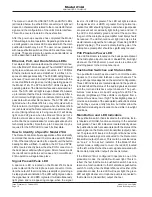
Model 214A User Guide
Issue Preliminary 1, October 2022
Studio Technologies, Inc.
Page 15
Model 214A
ANNOUNCER’S CONSOLE
Headphone Output – Sidetone
Choices are
Off
,
Main Button
,
Talkback Button
, and
Main and Talkback Buttons
.
STcontroller allows the Model 214A’s sidetone function to
be configured as desired. Sidetone is audio from the output
of the microphone preamplifier that is sent to the head
-
phone output channels. This can be important, allowing
the user to “hear” themselves for performance confirma
-
tion and comfort. Making a specific selection from among
the four available modes will depend on the needs of the
application. If a “full mix” is being provided to the Model
214A’s Dante receiver (input) channels then locally pro-
vided sidetone won’t be needed and the Off configuration
should be selected. The user will hear themselves by way
of the audio signals that are arriving via the Dante receiver
(input) channels. But if “mix-minus” audio is being supplied
to the Model 214A then selecting one of the headphone
source and routing modes which enables sidetone (modes
1, 2, or 3) can be an important means of establishing user
confidence. The selected sidetone mode will determine
exactly when sidetone audio will be sent to the headphone
output channels.
Off:
In this mode, the sidetone function is not active.
Main Button:
In this mode, the sidetone function will be
active whenever the main button function is active and
audio associated with the microphone preamplifier is pres
-
ent on the Dante main transmitter (output) channel.
Talkback Button:
In this mode, the sidetone function will
be active whenever the talkback button is active and audio
associated with the microphone preamplifier is present on
the Dante talkback transmitter (output) channel.
Main and Talkback Buttons:
In this mode, the sidetone
function will be active whenever the main or talkback but-
tons are active and audio associated with the microphone
preamplifier is present on the Dante main or Dante talkback
transmitter (output) channels.
Headphone Output – Gain Range
Choices are
High
and
Low
.
STcontroller is used to select the overall level of the
headphone output channels. The default setting,
Low
, is
designed so that users with typical audio input sources will
be inclined to set the three rotary level controls at approxi-
mately 50% of their rotation. This would be appropriate for
most applications. The
High
setting would be applicable
in cases where an extreme headphone output level is re-
quired or the level of the audio input sources is lower than
typical. Using the High setting in the former application is
not recommended as hearing damage could result from
exposure to high signal levels.
Headphone Output – Minimum Level
Choices are
–40 dB
or
Full Mute
.
STcontroller allows selection of the headphone output’s
minimum level. In the
–40 dB
setting the minimum head-
phone output level is approximately 40 dB below the
maximum output level; the headphone output will never
fully mute. This ensures that audio signals present on the
selected Dante receiver (input) channels will always be
present on the headphone output channels. In most on-
air broadcast applications this is the appropriate setting,
ensuring that some level of signal is always present.
When
Full Mute
is selected moving any level control to its
fully counterclockwise position will cause its associated
channel to fully mute. If a level control is set to serve as a
balance control, moving it to either its fully counterclockwise
or its fully clockwise position will cause the associated sig-
nal to mute. Selecting the Full Mute mode may be appropri-
ate for applications where minimizing the chance of audio
“leakage” into an active microphone is important. As an
example, this setting could be useful when the connected
headset or headphones are at times placed on a desk or
tabletop, adjacent to on-air talent.
Note that when level control C, located on the right side of
the front panel, has been configured to control the sidetone
level the configuration of the headphone output minimum
level mode will not impact it. When level control C is used
for sidetone, setting it to its fully counterclockwise position
will always cause the sidetone output level to fully mute.
Button Operation – Main
Choices are
Push to Mute
,
Push to Talk
,
Latching
,
Push
to Talk/Tap to Latch
, and
Push to Mute/Tap to Latch
.
STcontroller allows the operating mode of the main button
to be configured. There are five choices available:
Push to Mute:
If this mode is selected, the main button func-
tion will normally be active. The audio signal associated with
the output of the microphone pre-amplifier will be routed to
the Dante main transmitter (output) channel. Whenever the
main button is pressed this audio signal will not be present
on the Dante main transmitter (output) channel.
Push to Talk:
If this mode is selected, the main button func-
tion will normally be inactive. The audio signal associated
with the microphone pre-amplifier will not be present on
the Dante main transmitter (output) channel. Whenever the
main button is pressed the audio signal will become active
on the Dante main transmitter (output) channel.
Latching:
If this mode is selected, the main button’s function
will alternate between its active and inactive states when-
ever the main button is pressed. Upon Model 214A power
up the function will be in its inactive state.













































